Your sun-baked food takes extra time because several factors can slow down the solar cooking process. When clouds roll in, they reduce UV radiation and extend cooking by 25-50%. If you don't refocus your solar oven every 25-30 minutes, you'll add 10-15 minutes to cooking time. Opening the oven door drops temperatures by 25°F and requires 15 minutes to recover. Larger food portions need even longer, as they cause steeper initial temperature drops. Weather patterns, pot placement, and your cooking techniques all play significant roles in determining how quickly your meal will be ready. Mastering these elements can help you achieve more efficient solar cooking results.
Sun Intensity and Cooking Time

When planning to cook with solar energy, understanding the relationship between sun intensity and cooking time is essential.
You'll get the best results between 11:00 am and 3:00 pm, when the sun's overhead position provides maximum UV radiation and heat.
During these peak hours, you're able to reach higher temperatures that are perfect for baking and intensive cooking methods.
You can start as early as 10:00 am to preheat your solar cooker and continue until 4:00 pm to maintain cooking temperatures.
For slow-cook dishes, you'll find that the consistent heat during this window lets food simmer steadily.
In high-altitude locations, you may experience clearer sky conditions but need to account for colder temperatures affecting your cooking times.
Remember that seasonal changes affect cooking times considerably.
You'll need more time to prepare meals during fall and winter months when the sun's rays are less intense and daylight hours are shorter.
Cloud Cover Effects
Different types of clouds will impact your solar cooking differently, with thick, low clouds greatly reducing cooking temperatures while high, thin clouds allowing more sunlight through.
Clouds emit downwelling infrared radiation that can affect surface temperatures, though this has minimal impact on solar cooking effectiveness.
You'll need to adjust your cooking strategy by adding extra time on cloudy days, as increased cloud cover directly leads to lower temperatures and slower cooking rates.
When clouds block the sun's radiation, you can expect temperature drops that may extend cooking times by 25-50% or even make solar cooking impractical if cloud cover becomes too dense.
Types of Cloud Impact
Understanding cloud cover effects is essential for successful sun-based cooking, as clouds greatly influence both temperature and cooking duration.
You'll find that different cloud types impact your cooking time in varying ways. When clouds reflect sunlight back into space, they reduce solar energy reaching your food by up to 5°C, which means you'll need to extend cooking times considerably.
Even partial cloud cover will slow down your cooking process since it's directly related to the amount of solar energy that reaches the Earth's surface. You'll notice this effect is most pronounced during daytime hours when you're trying to harness the sun's heat. The presence of clear daytime skies allows maximum solar radiation to reach your food, resulting in optimal cooking conditions.
High humidity, which often accompanies cloud cover, can further impact your cooking times, as it's inversely related to temperature and can make your sun-based cooking less efficient.
Adjusting Cooking Strategies
Cloud cover challenges require practical adjustments to your sun-baking methods. When you're expecting cloudy conditions, you'll need to plan for extended cooking times since clouds can reflect up to 60% of available sunlight.
You can adapt by starting your cooking earlier in the day or using solar reflectors to maximize the limited sunlight. This is especially important since clear skies maximize radiation reaching your cooking setup.
Keep an eye on weather forecasts and be ready to implement backup strategies. If you're using a solar oven, you might need to reposition it more frequently to track the available sunlight.
Consider investing in devices that concentrate sunlight to counteract cloud interference. When heavy cloud cover persists, you'll want to have alternative cooking methods ready.
Remember that flexibility is key—adjust your cooking approach based on real-time observations of cloud conditions.
Temperature Drop Effects
When sunlight encounters cloud cover, you'll notice considerable temperature drops that directly affect sun-baking performance.
Clouds reflect 30-60% of incoming sunlight back into space, reducing surface temperatures by up to 5°C (9°F). This reflection drastically slows your food's cooking process.
You'll find that cloud patterns create unpredictable cooking conditions. While clouds act like a blanket at night, keeping temperatures warmer by trapping heat close to Earth's surface, this effect won't help your daytime sun-baking.
Instead, the reduced solar energy means you'll need to extend cooking times considerably, similar to using a slow cooker. The inconsistent temperatures make it harder to achieve proper doneness, so you'll need to adjust your timing and expectations when clouds appear during your sun-baking session.
Oven Door Opening Delays
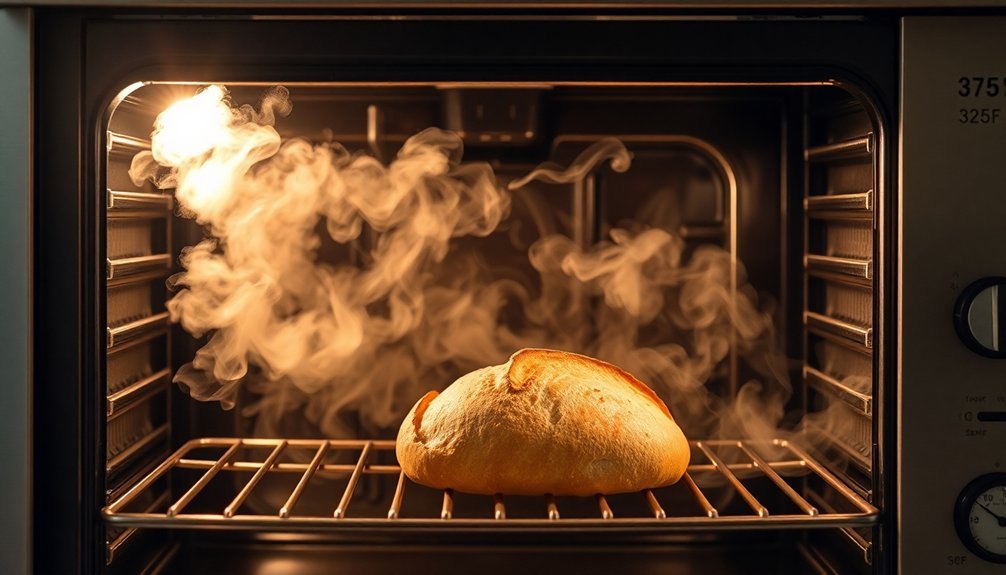
Opening your sun oven's door during cooking can drop temperatures by at least 25 degrees, requiring up to 15 minutes to regain ideal heat.
You'll find that each time you check your food, the total cooking duration increases considerably, with large items like whole chickens experiencing up to 50% heat loss.
To maintain consistent temperatures, you're better off using the viewing window and built-in thermometer rather than opening the door frequently.
Heat Loss Impact Analysis
Since heat loss greatly impacts cooking times in sun-baked food preparation, understanding the effects of oven door openings is crucial. You'll notice longer cooking times when heat escapes through gaps, seals, or frequent door openings. Poor insulation and placement near drafty areas can further disrupt your cooking process.
| Heat Loss Factor | Impact | Solution |
|---|---|---|
| Door Openings | Temperature Drop | Minimize Opening |
| Seal Condition | Energy Waste | Regular Maintenance |
| Insulation Quality | Uneven Cooking | Upgrade Materials |
| Oven Placement | Heat Disruption | Best Location |
When you're dealing with heat loss, you'll need to compensate by extending cooking times or increasing temperature settings. To maintain efficiency, confirm proper maintenance of door seals, use quality insulation, and position your oven away from drafts. These steps will help you achieve consistent cooking results while minimizing energy consumption.
Door Opening Time Consequences
Have you wondered how a simple oven door opening can disrupt your entire baking process? When you open your oven door, the temperature drops by 25°F or more, forcing your oven to work harder and longer to recover. This interruption affects critical chemical reactions and can turn your perfectly planned cake into a dense disappointment.
You'll notice extended cooking times and uneven baking as the temperature fluctuates.
- Your cake's gentle rise will collapse as cool air rushes in
- You'll watch helplessly as precious moisture escapes, leaving you with a dry texture
- Your energy bills will climb as your oven struggles to maintain temperature
- You'll waste valuable time waiting for the temperature to stabilize
Instead of opening the door, use your oven light and window to monitor your cake's progress.
Maintaining Temperature Control
While proper temperature control is essential for successful baking, maintaining it requires more than just setting the right number on your dial.
You'll need an accurate oven thermometer placed on the middle rack to monitor actual temperatures. After preheating, wait at least 10 minutes for the temperature to stabilize before taking multiple readings.
If you discover your oven's running more than 15 degrees off the set temperature, you'll need to calibrate it.
For digital ovens, access the calibration settings through your control panel and adjust the offset. With analog ovens, you can remove the temperature knob and turn the adjustment screws – clockwise if it's running hot, counterclockwise if it's cold.
Refocusing Frequency
When using a solar oven, you'll need to refocus it every 25-30 minutes to track the sun's movement across the sky. If you don't maintain proper alignment, your cooking time will increase considerably, with each missed adjustment adding 10-15 minutes to your total cooking duration.
The sun's angle changes throughout the day, and seasonal variations also affect how often you'll need to reposition your oven for ideal heat capture.
- Feel the satisfaction of perfectly timed meals when you stay committed to regular refocusing
- Experience the frustration of extended cooking times when you forget to adjust
- Enjoy the peace of mind knowing your food is cooking evenly and safely
- Embrace the rhythm of working with nature's daily cycles
Remember to use a food thermometer to guarantee proper cooking temperatures, regardless of variable conditions affecting your refocusing schedule.
Food Volume Impact
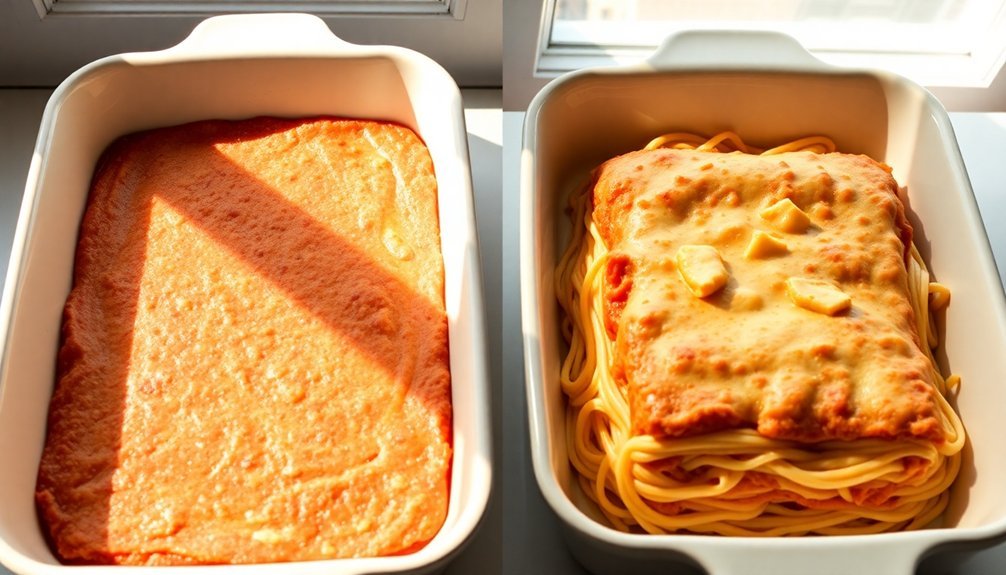
As you increase the amount of food in your solar oven, cooking times will extend beyond a simple proportional relationship. When you double your recipe, you'll need more than twice the cooking time due to several factors affecting heat distribution.
Your larger food volume will cause a steeper initial temperature drop in the oven, and heat takes longer to penetrate through the increased mass.
Foods with high water content retain heat differently, which impacts the cooking process. You'll notice that the surface-area-to-volume ratio plays an essential role in how evenly your food cooks.
To achieve better results with larger quantities, you might need to adjust your cooking technique. Consider cooking in batches or using a larger cooking surface, especially when browning is desired.
Dark Pan Heat Absorption
Dark pans play an essential role in solar cooking by absorbing and distributing heat more efficiently than their lighter counterparts. When using dark pans for sun-baked food, you'll notice faster cooking times, similar to how dark clothing warms up quickly in sunlight. However, this rapid heat absorption can lead to uneven cooking if you're not careful.
- Get excited about the enhanced heating power of your dark pans – they're like natural solar magnets!
- Feel confident knowing you're maximizing the sun's energy with peak heat absorption.
- Rest assured that your food will cook more thoroughly with dark pan's superior heat distribution.
- Experience the satisfaction of eco-friendly cooking using nature's own heat source.
To achieve the best results, consider using a silicone mat for more even heat distribution, and check your food's doneness earlier than usual, as it may cook faster than expected.
Seasonal Sun Position Changes

You'll notice significant changes in solar cooking times as the sun's position shifts between summer and winter solstices.
During winter months, you need to allow for longer cooking periods due to the sun's lower angle and reduced intensity of rays hitting your solar cooker.
Your summer solar cooking will benefit from more direct sunlight and shorter cooking times, especially when you position your cooker to track the sun's higher arc across the sky.
Solstice Sun Angle Impact
The sun's position throughout the year markedly affects cooking times in sun-baked food preparation. During summer solstice, you'll find that sunlight hits the ground more directly, concentrating its energy and reducing cooking times.
However, winter solstice brings lower sun angles that spread energy over a larger area, making your solar cooking less efficient.
- You'll experience longer cooking times during winter months when the sun's warmth feels frustratingly distant.
- You'll notice your food cooks fastest during summer when the sun's rays strike more intensely.
- You'll need extra patience at higher latitudes where the sun's angle varies dramatically.
- You'll appreciate understanding these patterns to plan your solar cooking schedule better.
Earth's 23.5° tilt creates this seasonal variation, which affects how efficiently you can harness solar energy for cooking throughout the year.
Winter Cooking Time Adjustments
Adapting to winter's shorter daylight hours requires considerable changes in your sun-baked cooking routine. You'll need to work within the peak sun hours of 11:00 AM to 3:00 PM, though even this window yields less intense sunlight than summer months.
| Time Factor | Winter Adjustment |
|---|---|
| Peak Hours | Limit cooking to 11 AM – 3 PM |
| Cooking Duration | Add 25-50% more time |
| Temperature | Expect lower maximum temps |
| Planning | Split recipes across days |
You'll need to adjust your cooking times considerably, as winter's weaker sunlight means foods take longer to reach proper temperatures. Consider breaking down complex recipes into multiple days, and use partial cooking techniques when needed. Pre-heating your solar oven earlier helps maximize the limited sunlight, while frequent repositioning guarantees you're capturing every available ray.
Summer Solar Positioning
During summer months, solar cooking becomes considerably more efficient as the sun climbs to a higher angle of 78 degrees in the sky, providing stronger and more direct sunlight for your cooking needs.
You'll benefit from extended daylight hours, with places like Arizona enjoying 14.5 hours of sun and New York experiencing up to 15.5 hours daily. The prime cooking window between 11:00 am and 3:00 pm offers ideal temperatures for baking bread, cakes, and other dishes with timing similar to conventional ovens.
- Feel the satisfaction of harnessing nature's power as your meals cook effortlessly
- Experience the joy of sustainable cooking while reducing your carbon footprint
- Embrace the freedom of leaving your solar oven unattended during peak hours
- Delight in consistent cooking results thanks to summer's reliable sunlight
Temperature Monitoring Tips
Proper temperature monitoring stands as a cornerstone of successful sun-baked food preparation.
You'll need a calibrated thermometer to guarantee your sun-cooked meals reach safe temperatures. Check your thermometer's accuracy by testing it in ice water (32°F) and boiling water (212°F), adjusting for your altitude.
When checking your sun-baked dishes, insert the thermometer into the thickest part of the food, avoiding bones. Wait for the reading to stabilize before recording the temperature.
Remember that ground meats must reach 160°F, chicken requires 165°F, and medium-rare steaks need 145°F. Take multiple readings across different areas of your food to confirm even cooking.
Don't forget to clean and sanitize your thermometer between uses to prevent cross-contamination and maintain accurate readings.
Weather Pattern Influences
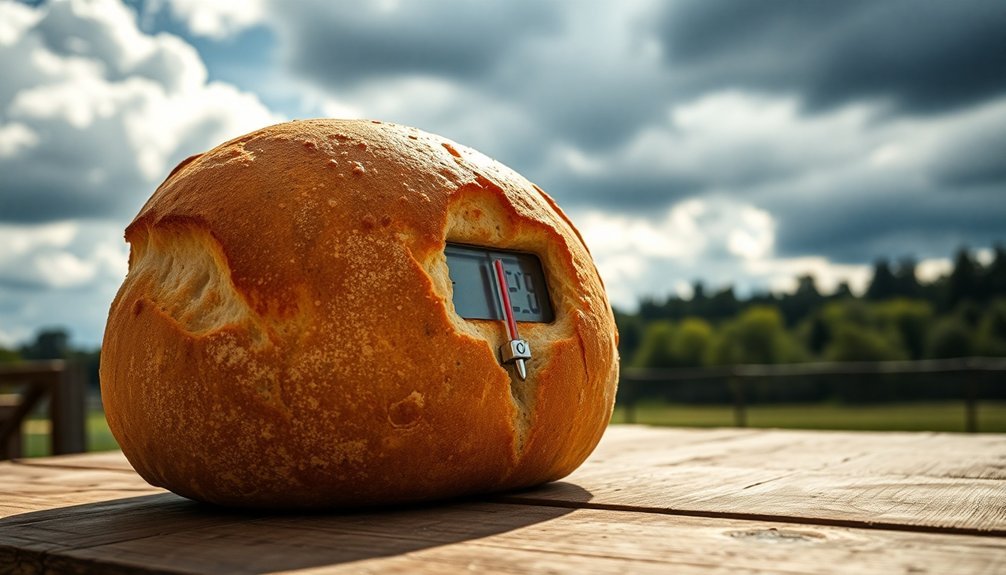
Weather patterns play an essential role in the success of sun-baked food preparation, as environmental conditions directly impact cooking times and results.
When you're working with sun-baked foods, humidity levels can greatly affect your cooking process by adding unwanted moisture to ingredients. High humidity will make your food take longer to cook, while warmer temperatures can cause ingredients to behave unpredictably.
You'll need to adjust your cooking times and ingredient ratios accordingly.
- Feel the frustration of watching your carefully prepared dish take twice as long on a humid day
- Experience the disappointment of inconsistent results when weather conditions change unexpectedly
- Celebrate the satisfaction of mastering weather-related adjustments to achieve perfect results
- Embrace the challenge of adapting your techniques to nature's ever-changing patterns
Pot Placement Strategies
Beyond weather considerations, mastering pot placement can make or break your sun-baked cooking success.
You'll need to position your black pot at the focal point of your cooker, especially if you're using a parabolic design. Don't wrap your pot in aluminum foil, as this reflects sunlight away from your food instead of absorbing it.
Place your pot in the center of the cooker and seal it inside a high-temperature oven bag to trap heat.
You'll get better results by using cookware specifically designed for solar cooking or by painting regular pots black.
Make sure you're using the EZ-Sun Track indicators or similar guides to maintain proper alignment, and adjust your pot's position every 10-20 minutes as the Sun moves across the sky.
Defrosting Time Requirements
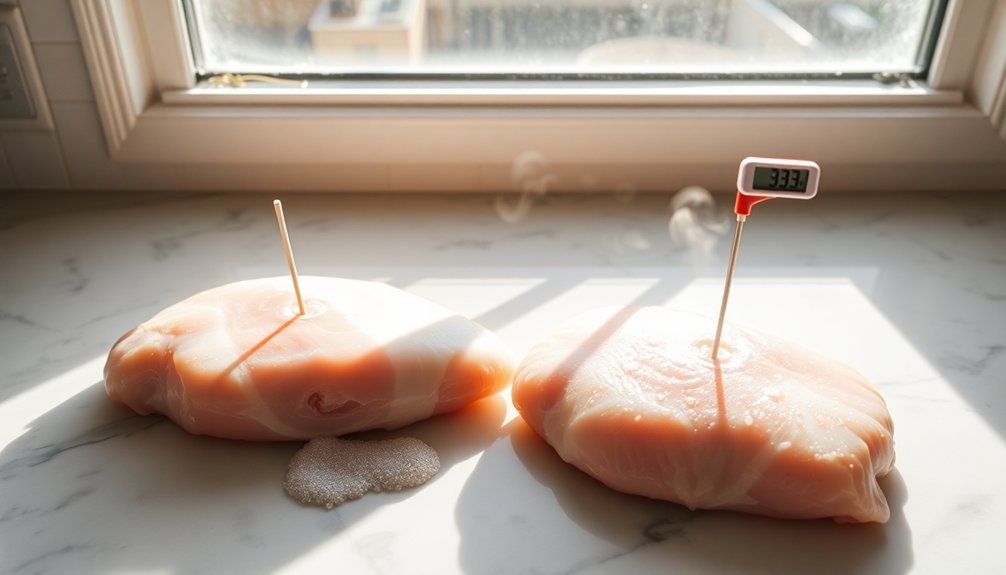
When using a solar cooker, you'll need to plan ahead for defrosting frozen ingredients since they require specific thawing times. The size and type of your ingredients greatly impact how long they'll take to thaw safely.
While you might be tempted to speed up the process using warm temperatures, this can lead to bacterial growth and spoilage.
- Your heart will sink if you discover partially thawed food right when you're ready to start solar cooking.
- You'll feel more confident knowing your ingredients are safely thawed in the refrigerator overnight.
- There's nothing more frustrating than waiting for thick frozen blocks to reach the right temperature.
- You'll love how individually frozen items thaw more quickly and evenly.
Consider using a thermal data logger to track your ingredient's temperature throughout the thawing process, ensuring food safety and ideal results.
Frequently Asked Questions
Can Reflective Foil Boost Cooking Speed in a Sun Oven?
Yes, you'll cook faster with reflective foil in your sun oven. It bounces more sunlight into your cooker, boosts internal temperatures considerably, and can double cooking speed when you're using high-quality aluminum foil tape.
Does Altitude Affect Solar Cooking Performance and Time?
Yes, altitude impacts your solar cooking considerably. You'll get better performance at higher elevations due to thinner air and less atmospheric interference. Your food will cook faster with more intense solar radiation at higher altitudes.
How Do Different Colored Foods Impact Absorption of Solar Heat?
When you're solar cooking, darker-colored foods like black beans and brown rice absorb heat faster than lighter foods like potatoes or pasta. You'll notice darker foods generally cook more quickly in your solar cooker.
Will Cooking Multiple Dishes Simultaneously Affect the Taste of Each Item?
Yes, your dishes can exchange flavors when cooked together. You'll notice this especially with strong-flavored foods. It's best to separate sweet and savory items to prevent unwanted flavor mixing in the oven.
Can Wind Speed and Direction Influence Solar Cooking Effectiveness?
Yes, wind can greatly affect your solar cooking success. You'll find that higher wind speeds increase heat loss, while direction impacts temperature stability. It's best to use windbreaks and choose sheltered spots when cooking.
In Summary
You'll find that sun-baked food requires extra time due to various factors you can't fully control. From shifting cloud patterns to the sun's changing position, you're dealing with an inconsistent heat source. When you're cooking with solar power, remember to account for weather variations, proper pot placement, and regular temperature checks. Patience and flexibility are your best tools for successful sun-baked meals.

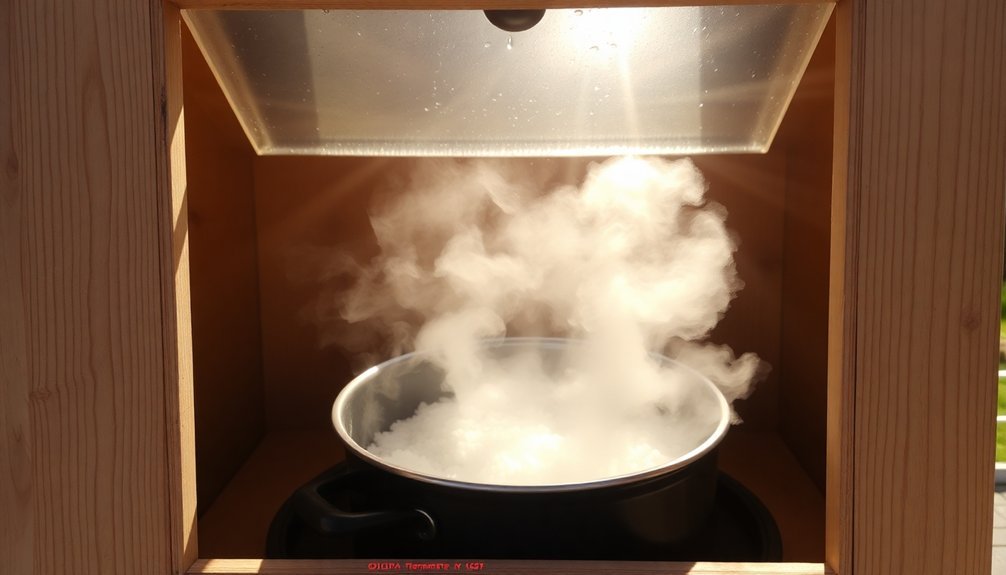



Leave a Reply